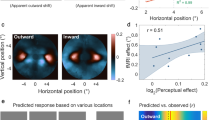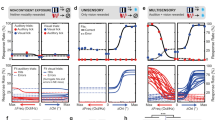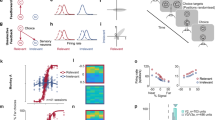Abstract
The mammalian visual system contains an extensive web of feedback connections projecting from higher cortical areas to lower areas, including primary visual cortex. Although multiple theories have been proposed, the role of these connections in perceptual processing is not understood. We found that the pattern of functional magnetic resonance imaging response in human foveal retinotopic cortex contained information about objects presented in the periphery, far away from the fovea, which has not been predicted by prior theories of feedback. This information was position invariant, correlated with perceptual discrimination accuracy and was found only in foveal, but not peripheral, retinotopic cortex. Our data cannot be explained by differential eye movements, activation from the fixation cross, or spillover activation from peripheral retinotopic cortex or from lateral occipital complex. Instead, our findings indicate that position-invariant object information from higher cortical areas is fed back to foveal retinotopic cortex, enhancing task performance.
This is a preview of subscription content, access via your institution
Access options
Subscribe to this journal
Receive 12 print issues and online access
$209.00 per year
only $17.42 per issue
Buy this article
- Purchase on Springer Link
- Instant access to full article PDF
Prices may be subject to local taxes which are calculated during checkout







Similar content being viewed by others
References
Murray, S.O. & Wojciulik, E. Attention increases neural selectivity in the human lateral occipital complex. Nat. Neurosci. 7, 70–74 (2004).
Murray, S.O., Kersten, D., Olshausen, B.A., Schrater, P. & Woods, D.L. Shape perception reduces activity in human primary visual cortex. Proc. Natl. Acad. Sci. USA 99, 15164–15169 (2002).
Harrison, L.M., Stephan, K.E., Rees, G. & Friston, K.J. Extra-classical receptive field effects measured in striate cortex with fMRI. Neuroimage 34, 1199–1208 (2007).
Heinen, K., Jolij, J. & Lamme, V.A. Figure-ground segregation requires two distinct periods of activity in V1: a transcranial magnetic stimulation study. Neuroreport 16, 1483–1487 (2005).
Hupé, J.M. et al. Cortical feedback improves discrimination between figure and background by V1, V2 and V3 neurons. Nature 394, 784–787 (1998).
Rossi, A.F., Desimone, R. & Ungerleider, L.G. Contextual modulation in primary visual cortex of macaques. J. Neurosci. 21, 1698–1709 (2001).
Corthout, E. & Supèr, H. Contextual modulation in V1: the Rossi-Zipser controversy. Exp. Brain Res. 156, 118–123 (2004).
Ress, D. & Heeger, D.J. Neuronal correlates of perception in early visual cortex. Nat. Neurosci. 6, 414–420 (2003).
Jehee, J.F.M., Roelfsema, P.R., Deco, G., Murre, J.M.J. & Lamme, V.A.F. Interactions between higher and lower visual areas improve shape selectivity of higher level neurons—explaining crowding phenomena. Brain Res. 1157, 167–176 (2007).
Supèr, H., Spekreijse, H. & Lamme, V.A.F. Two distinct modes of sensory processing observed in monkey primary visual cortex (V1). Nat. Neurosci. 4, 304–310 (2001).
Op de Beeck, H.P., Baker, C., DiCarlo, J. & Kanwisher, N. Discrimination training alters object representations in human extrastriate cortex. J. Neurosci. 26, 13025–13036 (2006).
Haxby, J.V. et al. Distributed and overlapping representations of faces and objects in ventral temporal cortex. Science 293, 2425–2430 (2001).
Norman, K.A., Polyn, S.M., Detre, G.J. & Haxby, J.V. Beyond mind-reading: multi-voxel pattern analysis of fMRI data. Trends Cogn. Sci. 10, 424–430 (2006).
Cox, D.D. & Savoy, R.L. Functional magnetic resonance imaging (fMRI) 'brain reading': detecting and classifying distributed patterns of fMRI activity in human visual cortex. Neuroimage 19, 261–270 (2003).
Williams, M.A., Dang, S. & Kanwisher, N. Only some spatial patterns of fMRI response are read out in task performance. Nat. Neurosci. 10, 685–686 (2007).
Malach, R. et al. Object-related activity revealed by functional magnetic resonance imaging in human occipital cortex. Proc. Natl. Acad. Sci. USA 92, 8135–8139 (1995).
Schwarzlose, R.F., Swisher, J.D., Dang, S. & Kanwisher, N. The distribution of category and location information across object-selective regions of visual cortex. Proc. Natl. Acad. Sci. USA 105, 4447–4452 (2008).
Olman, C.A., Inatib, S. & Heeger, D.J. The effect of large veins on spatial localization with GE BOLD at 3 T: displacement, not blurring. Neuroimage 34, 1126–1135 (2007).
Treue, S. & Martinez-Trujillo, J.C. Feature-based attention influences motion processing gain in macaque visual cortex. Nature 399, 575–579 (1999).
Serences, J.T. & Boynton, G.M. Feature-based attentional modulations in the absence of direct visual stimulation. Neuron 55, 301–312 (2007).
Saenz, M., Buracas, G.T. & Boynton, G.M. Global effects of feature-based attention in human visual cortex. Nat. Neurosci. 5, 631–632 (2002).
Haynes, J.D. & Rees, G. Predicting the stream of consciousness from activity in human visual cortex. Curr. Biol. 15, 1301–1307 (2005).
Carlson, T.A., Schrater, P. & He, S. Patterns of activity in the categorical representations of objects. J. Cogn. Neurosci. 15, 704–717 (2003).
Angelucci, A. et al. Circuits for local and global signal integration in primary visual cortex. J. Neurosci. 22, 8633–8646 (2002).
Bressler, D., Spotswood, N. & Whitney, D. Negative BOLD fMRI Response in the visual cortex carries precise stimulus-specific information. PLoS ONE 2, e410 (2007).
Merriam, E.P., Genovese, C.R. & Colby, C.L. Remapping in human visual cortex. J. Neurophysiol. 97, 1738–1755 (2007).
Slotnick, S.D., Thompson, W.L. & Kosslyn, S.M. Visual mental imagery induces retinotopically organized activation of early visual areas. Cereb. Cortex 15, 1570–1583 (2005).
Mumford, D. On the computational architecture of the neocortex. I. The role of the thalamo-cortical loop. Biol. Cybern. 65, 135–145 (1991).
Gilbert, C.D. & Sigman, M. Brain states: top-down influences in sensory processing. Neuron 54, 677–696 (2007).
Lee, T.S. & Mumford, D. Hierarchical Bayesian inference in the visual cortex. J. Opt. Soc. Am. A Opt. Image Sci. Vis. 20, 1434–1448 (2003).
Logothetis, N.K., Pauls, J., Augath, M.A., Trinath, T. & Oeltermann, A. Neurophysiological investigation of the basis of the fMRI signal. Nature 412, 150–157 (2001).
Viswanathan, A. & Freeman, R.D. Neurometabolic coupling in cerebral cortex reflects synaptic more than spiking activity. Nat. Neurosci. 10, 1308–1312 (2007).
Wilke, M., Logothetis, N.K. & Leopold, D.A. Local field potential reflects perceptual suppression in monkey visual cortex. Proc. Natl. Acad. Sci. USA 103, 17507–17512 (2006).
Dougherty, R.F. et al. Visual field representations and locations of visual areas V1/2/3 in human visual cortex. J. Vis. 3, 586–598 (2003).
Fischl, B., Sereno, M.I. & Dale, A.M. Cortical surface-based analysis. II. Inflation, flattening and a surface-based coordinate system. Neuroimage 9, 195–207 (1999).
Acknowledgements
We would like to thank the members and friends of the Kanwisher laboratory for useful comments on the manuscript. M.A.W. was supported by a grant from the Australian National Health and Medical Research Council (C.J. Martin Fellowship) and H.P.O.d.B. was supported by the Research Foundation Flanders. This work was supported by grants from the US National Institutes of Health to N.K. (grants EY013455 and EY016159). We would also like to thank the Athinoula A. Martinos Imaging Center at the McGovern Institute for Brain Research for subsidizing the cost of scanning.
Author information
Authors and Affiliations
Contributions
M.A.W. conducted Experiments 1–3, 5 and 6, designed Experiment 4 and wrote the manuscript. C.I.B. and H.P.O.d.B. were involved in the design and implementation of all of the studies and writing the manuscript, and H.P.O.d.B. also created the stimuli. W.M.S. conducted Experiment 4. S.D. wrote specialized eye tracking analysis programs, programmed the experiments and helped with data collection. C.T. optimized the neuroimaging sequences and N.K. supervised the entire project, including writing the manuscript.
Corresponding author
Supplementary information
Supplementary Text and Figures
Supplementary Figures 1–5 (PDF 931 kb)
Rights and permissions
About this article
Cite this article
Williams, M., Baker, C., Op de Beeck, H. et al. Feedback of visual object information to foveal retinotopic cortex. Nat Neurosci 11, 1439–1445 (2008). https://doi.org/10.1038/nn.2218
Received:
Accepted:
Published:
Issue Date:
DOI: https://doi.org/10.1038/nn.2218
This article is cited by
-
Layer-specific, retinotopically-diffuse modulation in human visual cortex in response to viewing emotionally expressive faces
Nature Communications (2022)
-
Assessing functional reorganization in visual cortex with simulated retinal lesions
Brain Structure and Function (2021)
-
Biologically inspired visual computing: the state of the art
Frontiers of Computer Science (2021)
-
Figure-ground perception in the awake mouse and neuronal activity elicited by figure-ground stimuli in primary visual cortex
Scientific Reports (2018)
-
Visual Cortex Plasticity Following Peripheral Damage To The Visual System: fMRI Evidence
Current Neurology and Neuroscience Reports (2016)



